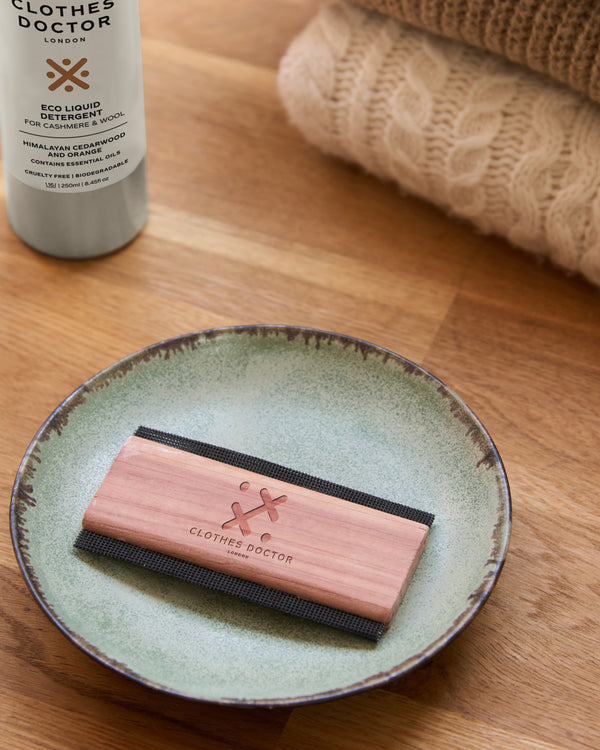When it comes to washing clothes, no one appreciates more than us how confusing it can be sometimes, when confronted with a care label with some strange symbols on it, or just simply saying 'dry clean only'. Not to mention all the different wash cycles on our machines, temperature settings, detergent options and whether to tumble dry or not to tumble dry.

Well, we want to uncomplicate things for you, by going back to basics and sharing some washing principles that you can store up for any washing decision to come! So never again will your hand hesitate on the dial, but you can confidently pick your cycle and get on with your day.
THE SCIENCE BEHIND WASHING YOUR CLOTHES
To begin with, it's worth understanding a bit more about what 'ingredients' you need to wash your clothes. The washing process is about lifting dirt and grease from your clothes, and washing them away down the drain. The essentials to do this are:
- Water - this is the fundamental 'active ingredient' for cleaning. When it permeates into clothing fibres and rubs against dirt and grease, it washes it away, but it can't do this alone.
- Detergent - this helps the water clean better. It contains active ingredients called surfactants. The surfactant molecules help the water to permeate the clothes better, whilst another part of the molecules attaches to dirt and grease and helps to lift it away.
- Movement or 'agitation' - this helps to break down dirt and grease into smaller particles which are easier to lift and wash away. However it adds wear and tear to clothing, damages fibres and causes microfibres to be released into the water.
There is one other useful, but not essential ingredient, and that's Heat. The more heat you add, the less hard the water and detergent have to work to lift stains. The problem is that hot water can damage and shrink clothes, can cause dyes to run, and also uses a lot of energy to heat up. So the aim is to get your clothes clean, with the minimum necessary amount of heat and movement applied.
IF YOU'RE WASHING BY MACHINE
1. Loading...

To start off, it's important to know if you're loading the washing machine correctly. We’ve all overloaded the washing machine at one time or another...but did you know that overloading your machine you can actually damage its drum and decrease your washer’s efficiency? Also, by overloading, the clothes may not be able to achieve the movement necessary to break down the dirt and grease particles. So, make sure you load your machine with a bit of space left over, and of course, that perfect dose of scented detergent. We recommend you load your machine by fabric type as follows:
- Cottons: fill the machine 3/4 full.
- Synthetics and delicates: fill the machine 1/2 full.
- Quick wash: fill the machine 1/2 full.
2. Get the right dose!

How much detergent to use depends on how dirty your clothes are, the hardness of your water and the size of the load.
Well, FYI, our eco washes have everything you need to get the perfect dose. There are guidelines on the label measured in capfuls, because, rather than creating a pointless measuring container to use and then discard, we've kept our packaging minimal: you can measure the doses straight into the cap.
3. Select the best wash cycle

Here's where our basic principles really come into action: in picking the right wash cycle. It ultimately comes down to the garment/fabric type and level of soiling. Here's how to do it:
COTTON
Cotton is a durable, hard-wearing garment, which will only see a small amount of shrinkage, but it is at risk of colours running if too much heat is applied.
-
High agitation wash
-
High-speed spin cycle
-
Should ideally be washed at 30-40 degrees, but white cotton can be washed at higher temperatures if it's heavily soiled
-
Use an everyday detergent that is specially formulated for low temperatures, like our No 2 Signature Wash.
SYNTHETICS
Particularly try to minimise agitation with synthetic fibres, as microfibre release is a huge issue. They will still clean well on a lower speed cycle. If they're heavily soiled, add a dose of our Stain Remover to the drum for cleaning super-powers!
- Medium agitation wash
- Low-speed spin cycle
- Warm to cool temperature (between 30 and 40 degrees)
- We recommend washing synthetic fibres with our Basil and Mandarin Leaf Duo Set, as the detergent is the perfect partner to give a deep clean to your everyday clothes and add the fabric conditioner to soften and leave a beautiful lingering scent. Our customers love our Basil & Mandarin Leaf Eco Liquid Detergent and Fabric Conditioner so much, that we've made it available by subscription, so you never run out again, save 15% and get FREE shipping always.
DELICATES
Protect your delicate garments by taking things down a notch. Low speed spin, low temperatures, and a gentle detergent like our No 4
- Low agitation wash
- Low-speed spin cycle
- Low temperatures (max 30 degrees)
- Pour 2-3 caps of our Eco Wash for Silk and Delicates into the machine drawer and don't forget to remove promptly at the end of the cycle.
QUICK WASH
Basically everyday washing that needs to be done quickly, with minimal soiling, but not for delicate garments.
- Shortened wash cycle
- High-speed spin cycle
- Low temperatures (max 30 degrees)
- Pour our Signature Eco Wash into your machine drawer. It's ideal for low-temperature washing, saving on water and energy during the washing cycle too.
AVOID THE WASH
For those moments when your clothes are not visibly dirty, and you know they were worn only a couple of times, then avoid washing them all together! This protects the fabric quality, while also helping you cut down on a few loads a week. Our Clothing Spritz removes all odours, and kills 96% of bacteria meaning you don't feel guilty about washing your most precious clothes less!
WASH SILK, WOOL AND CASHMERE BY HAND
We recommend that you hand wash all silk, wool and cashmere garments. The reason is that these fabrics are especially prone to shrinking, damage and colour run, and hand washing means you can control the amount of Detergent, Movement and Heat that you need as you go. Even better, you can visually see if the stains are coming out, or if not, leave a little longer. So it's a great way to clean your most delicate items in a controlled way.
Our Eco Wash for Cashmere and Wool and Eco Wash for Silk and Delicates are both gentle, pH neutral formulations that are perfect for this process. Most detergents have higher alkalinity that can damage natural fibres. Not sure how to do this at home? Just follow our guides below:
If you're looking for that perfect partner to fit your laundry personality, browse through our subscription boxes. Bring a little slice of pleasure and luxury to your routine by receiving regular deliveries of delightful detergents, then sit back, relax, and start looking forward to laundry day again!








